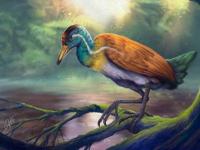Cretaceous-Period Bird from China ‘Had Dinosaur Skull’

Paleontologists have described a new enantiornithine bird with a well-preserved skull from the Early Cretaceous of northeastern China.
The newly-identified bird species lived in what is today China’s Liaoning province during the Early Cretaceous period, some 120 million years ago.
The ancient creature had a 2-cm- (0.8-inch) long skull with a mix of dinosaurian and bird features.
It belongs to Enantiornithes (opposite birds), an extinct group of toothed birds known exclusively from the Cretaceous period and predominantly from fossils discovered in Asia.
“Enantiornithes are the most diverse group of birds from the time of the dinosaurs in the Cretaceous and have been found all over the world,” said Professor Min Wang, a paleontologist at the Institute of Vertebrate Paleontology and Paleoanthropology and the CAS Center for Excellence in Life and Paleoenvironment at the Chinese Academy of Sciences, and colleagues.
“In living birds, the quadrate is one of the most movable bones in the skull and allows for the unique feature of living birds known as ‘kinetic skull,’ which allows the upper jaw to move independently of the brain and the lower jaw.”
“In contrast with living birds, however, the skull of this new ‘opposite bird,’ as well as those of dinosaurs like Tyrannosaurus rex and the close dinosaurian relatives of birds (e.g., troodontids and dromaeosaurs), is not kinetic. Instead, its bones are ‘locked up’ and unable to move.”
“The temporal regions of the skull of this bird are very different from living birds.”
The new enantiornithine bird has two bony arches for jaw muscle attachment like those found in reptiles such as lizards, alligators, and dinosaurs, making the rear of the skull rigid and resistant to movement among the bones.
“When reconstructing all parts of the skull three-dimensionally from the high resolution CT scans of the fossil, we had a problem figuring out one bone in particular,” Professor Wang said.
The researchers compared CT scans of the bird skull to scans of the skull of the well-known dromaeosaur Linheraptor from Inner Mongolia, China.
The results show that many other features of the rear portion of the bird’s skull, including the shape of the basisphenoid bone and its connections with other skull bones, also resemble dromaeosaurs rather than living birds.
“The fossil bird and dinosaurs also lack the discrete contact between the pterygoid and quadrate near the palate that is used in skull kinesis in living birds,” said Dr. Thomas Stidham, a paleontologist at the Institute of Vertebrate Paleontology and Paleoanthropology and the CAS Center for Excellence in Life and Paleoenvironment at the Chinese Academy of Sciences and the University of Chinese Academy of Sciences.
“In combination with the ‘locked up’ temporal bones, the difference in the palate structure also points to the absence of kinesis among early birds.”
“Having a ‘dinosaur’ skull on a bird body certainly did not stop the enantiornithines, or other early birds, from being highly successful in places all around the world for tens of millions of years during the Cretaceous,” Professor Wang said.
The findings were published in the journal Nature Communications.
_____
M. Wang et al. 2021. Cretaceous bird with dinosaur skull sheds light on avian cranial evolution. Nat Commun 12, 3890; doi: 10.1038/s41467-021-24147-z
Source: www.sci-news.com/








